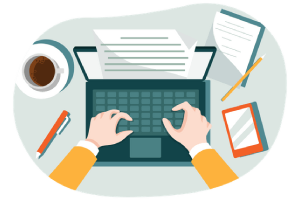The ability to bridge cultures, break barriers, and foster collaboration was one of AI's most profound impacts. Aarav's journey would take him to virtual meetings, translation hubs, and communities where AI was shaping how people interacted across borders.
Aarav's first stop was a tech startup in Bengaluru called PolyLingua, a company specializing in AI-powered real-time translation tools. The office hummed with activity as engineers fine-tuned algorithms and tested new features.
"Language should never be a barrier," said Riya, the company's co-founder, as she handed Aarav a small, sleek device. "This is Echo, our latest creation. It translates conversations in real time, no matter the language."
Riya demonstrated Echo's capabilities by speaking in Hindi while Aarav responded in English. The device translated each statement instantly, preserving tone and context.
"It's not just about words," Riya explained. "It's about meaning. Echo understands cultural nuances, ensuring the translation feels natural."
Aarav imagined the possibilities - business deals, international travel, and even friendships made easier through such tools. "What's the biggest challenge?" he asked.
"Data," Riya admitted. "Languages are dynamic, and training AI to keep up with slang, dialects, and idioms is a never-ending task."
Aarav noted: AI breaks language barriers but requires constant evolution to stay relevant.
Next, Aarav attended a virtual meeting hosted by GlobalSynergy, an organization connecting professionals worldwide. Participants logged in from their homes, offices, and coworking spaces, their faces appearing on a grid of screens.
The platform used AI to match participants based on their expertise and project needs. Aarav observed as a graphic designer from Brazil collaborated with a marketer in Japan and a software developer in Kenya.
"AI analyzes user profiles, interests, and skills to create the perfect teams," explained Deepak, GlobalSynergy's CEO. "It's like LinkedIn, but actionable."
Aarav asked the participants about their experiences.
"It's amazing," said Maria, the marketer. "I've worked on projects I'd never have access to locally."
"But it's not perfect," added Pedro, the designer. "Time zones can be tricky, and sometimes AI matches us based on skills but not personalities."
Aarav wrote: AI fosters global collaboration but must address human dynamics to create truly cohesive teams.
In Jaipur, Aarav visited a school that participated in an AI-driven global learning program. Students connected with peers in other countries to solve problems, share cultures, and learn together.
The day's lesson involved climate change. Aarav watched as Indian students brainstormed solutions with their counterparts in Sweden, guided by an AI that translated their discussions and provided relevant data.
"This is what education should be," said Mrs. Sharma, the principal. "AI allows our students to see the world as one interconnected community."
But there were challenges. "Not all schools can afford this technology," Mrs. Sharma admitted. "We need to ensure it doesn't widen the gap between the privileged and the underserved."
Aarav noted: AI in education can unite the world but risks deepening inequalities if access isn't universal.
One of Aarav's most heartwarming encounters was with Ayesha, a college student who had made friends worldwide through an AI-powered language exchange app.
"I've learned French and Japanese," Ayesha said, showing Aarav her chat history filled with messages from friends in Paris and Tokyo. "But it's more than just language. We share our cultures, traditions, and dreams."
Ayesha demonstrated how the app used AI to suggest topics based on users' interests and correct their grammar in real time.
"What's the best part?" Aarav asked.
"Feeling connected," Ayesha said. "Even if I've never met them in person, I know I have friends everywhere."
Aarav smiled, jotting: AI creates bridges of friendship, turning strangers into global neighbors.
However, the promise of global connectivity wasn't without its pitfalls. Aarav visited a media organization that used AI to combat misinformation in cross-border communication.
"We're seeing a rise in deepfakes and AI-generated propaganda," said Ankit, the editor-in-chief. "Misinformation spreads faster than ever, and AI is both the problem and the solution."
Ankit showed Aarav how their AI system flagged fake news, verified sources, and even tracked the origins of false narratives.
"But it's a race," Ankit warned. "For every tool we create, bad actors find new ways to exploit technology."
Aarav wrote: Global connectivity must balance freedom of expression with the responsibility to prevent harm.
Aarav's final meeting was with a psychologist, Dr. Kavita, who studied the impact of AI-driven global connectivity on mental health.
"While these tools connect us, they can also isolate us," Dr. Kavita said. "People may feel closer online but lonelier offline."
She shared stories of patients who struggled to form real-world relationships because they had become too reliant on digital interactions.
"The key is balance," Dr. Kavita said. "AI should enhance connections, not replace them."
Aarav jotted: AI must augment, not substitute, human interaction.
As Aarav prepared to leave Delhi, he reflected on the stories he had gathered. AI-powered global connectivity was a force for immense good, breaking barriers and fostering collaboration. But it also came with challenges - ethical dilemmas, misinformation, and the need for balance between digital and real-world interactions.
In his notebook, Aarav penned his thoughts: AI has the power to unite the world, but its true impact depends on how we navigate its complexities. The connections it fosters must serve to enhance our humanity, not overshadow it.
With these insights, Aarav boarded his train, ready to share the story of how AI was weaving the world into a closer, more connected tapestry.





